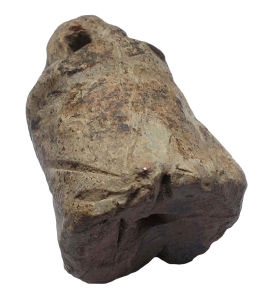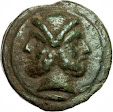Ancient Scale (and other) Weights
My wife wants to know why I am BUYING fishing weights! A short answer is: My coin collecting focus is Roman Republican coins. Most of these are silver denarii or struck bronze coins. I also have a nice group of cast bronze aes rude, bars and formed bronze from central Italy. An extension of my cast bronze collection is an interest in how did the Romans weigh (or portion) their cast bronze. Along this line of thought, I started reading about scales and collecting scale weights. I have several pieces that were certainly scale weights and others that may have been scale weights. Most of the may have been pieces are either cast bronze or lead. I do not have scale weights made from other materials yet: glass, stone and other metals.
The best of the best of this collection is a Roman bronze weight. I do not know what time period, but similar shaped weights were found in excavations at Pompeii. Shown below is this weight, a lead and a lead shell (the shell could be a weight or votive offering).
Items from the top picture, clockwise from top right:
1. From the seller: I am sending you a picture of a very interesting weight we recently receive in consignment. It looks like a byzantine weight, but it has a Roman inscription VNCIAS VI. The weight is 155g. VNCIAS is the word for ounce, this is why i think this is really interesting.
A Roman pound is about 324 grams and had 12 ounces called uncia. The Romans used V for both letters U & V. This weight weighs close to the "official" weight of a Semis or 6 Uncias.
2. an Italic votive lead scallop-shell, 59 grams
3. Sardo-Punic lead weight, 130 grams
Shown below are some Roman weights.
From a museum in Italy.
The Roman weights shown above and below are from a museum in Chester England.
The next two pics are weights from the Edward C. Streeter Collection of Weights and Measures Located at the Cushing/Whitney Medical Library, Yale University
Bruno Kisch was curator of the Streeter Collection at Yale when he wrote the book below. I have enjoyed the book and look here when I want to know a bit more about scale weights.
This summer I bought a group of small weights that were advertised as late Roman or Byzantine weights.
Clockwise from top left:
- N, 3.97 grams, 16.2 X 15.1 X 2 mm
- N, 4.32 grams, 13.7 X 10 X 4 mm
- four dots, 3.9 grams, 12.5 X 11.9 X 4 mm
I recently bought two lots of lead weights.
The first:
It was described as: Weight in pb to be catalogued. The 35 X 52 mm; over 250 grams (I am guessing that is the max of the seller's scale. I bought a heavier one to weigh the 388 gram bar I bought recently. I think this is a weaving loom weight.
The following lot fro the Chris Rudd collection is a big one at 1.7 Kg. I do not have it in hand, so can not speak individual pieces yet.
MEDIEVAL WEIGHT GROUP
12th-15th century AD
LOT 039
A mixed group of lead weights including barrel-shaped, discoid and biconvex. 1.7 kg total, 22-50mm (1 - 2").
Condition - Fine condition.
Provenance
The Chris Rudd collection, Norfolk, UK; formed since the 1970s; collection number DM4,8 and 9; found near Downham Market, Norfolk, UK.
Footnotes
Chris Rudd has collected ancient coins and antiquities since the 1940s. As an amateur archaeologist he found many himself at Badbury Rings, Dorset, 1952-53. He also dug at Hod Hill with Professor Sir Ian Richmond and at Wroxeter with Dame Kathleen Kenyon and Dr Graham Webster. Today he is best known as a Celtic coin dealer. His catalogues have been described as ‘an important research source’ by Professor Sir Barry Cunliffe and ‘treasure houses of delight’ by Dr Anne Ross. Coins and artefacts associated with Chris Rudd – as a collector, dealer and valuer – can be seen in The British Museum and other museums. This collection was formed since the 1970s.
12th-15th century AD
LOT 039
A mixed group of lead weights including barrel-shaped, discoid and biconvex. 1.7 kg total, 22-50mm (1 - 2").
Condition - Fine condition.
Provenance
The Chris Rudd collection, Norfolk, UK; formed since the 1970s; collection number DM4,8 and 9; found near Downham Market, Norfolk, UK.
Footnotes
Chris Rudd has collected ancient coins and antiquities since the 1940s. As an amateur archaeologist he found many himself at Badbury Rings, Dorset, 1952-53. He also dug at Hod Hill with Professor Sir Ian Richmond and at Wroxeter with Dame Kathleen Kenyon and Dr Graham Webster. Today he is best known as a Celtic coin dealer. His catalogues have been described as ‘an important research source’ by Professor Sir Barry Cunliffe and ‘treasure houses of delight’ by Dr Anne Ross. Coins and artefacts associated with Chris Rudd – as a collector, dealer and valuer – can be seen in The British Museum and other museums. This collection was formed since the 1970s.













